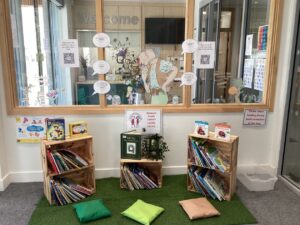
We are delighted to announce that our Lending Library is back. Please use the QR codes to sign your chosen books in and out. We are still missing quite a few books, if you have any please return them to the front office. Thank you.

We are delighted to announce that our Lending Library is back. Please use the QR codes to sign your chosen books in and out. We are still missing quite a few books, if you have any please return them to the front office. Thank you.
by Mrs Allison
After reading ‘Room on the Broom’ the children decided they would like to make their own Halloween potions. We used lots of natural ingredients like pumpkin seeds and pulp, herbs, spices and petals.
We had a few horrible ingredients too like Goblin snot and Giant’s toenails. The children used lots of different utensils to measure, stir, pour and mix our ingredients.
There was lots of great descriptive language being used when talking about our potions and the children came up with some brilliant names:
“Unicorn in a bush”
“Dragon fire”
“Stinky Slime”
Afterwards some of the children used their mark making skills to make potion recipe books.
by Miss McCallum
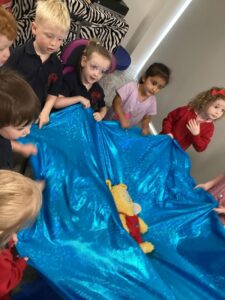 Bookbug promotes positive interactions through telling stories, singing songs, rhymes and play. We have been taking part in sessions over the past few months to help encourage new friendships and develop positive relationships between staff and children.
Bookbug promotes positive interactions through telling stories, singing songs, rhymes and play. We have been taking part in sessions over the past few months to help encourage new friendships and develop positive relationships between staff and children.
We have also started our family session within the centre and have loved seeing how many families have joined us so far. Sharing stories, songs and rhymes with your children also have a huge impact on your child’s language development. Taking a few minutes each day to read a story or sing a song will help form positive parent and child relationships and help develop the connections in a child’s brain that promote emotional development. It is also a great way to have fun!
by Mrs Sylvester
In the garden, some of the children have been enjoying a story about a hedgehog who learns the importance of friendship and being helpful. In the story, the hedgehog struggles to remove an apple from his spikes and is helped by a donkey.
To retell the story, we found a toy hedgehog and donkey but we also needed an apple. The children thought we should gather some apples from the apple tree in the nursery garden but unfortunately the apples were out of reach. With little success, the children independently tried to reach the apples using various techniques such as jumping up high, using hula-hoops and even sticks to reach the apples from the branches.

However, when the children shared ideas and worked together they were finally able to reach the apples. Just like in the story, the children learnt the value of friendship and teamwork!

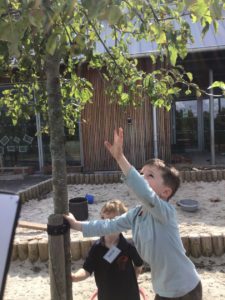
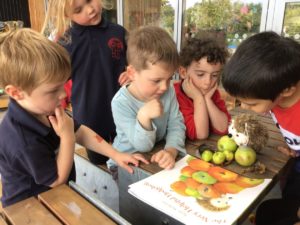
by Mrs Alison
The children have enjoyed learning about where honey comes from. We read a story called ‘The Beeman’ about a bee keeper and we also read a poem about the importance of honey bees.


The children learnt all about beehives and honeycomb and even tried some of the equipment that beekeepers use.
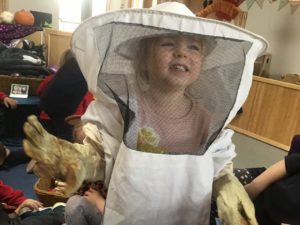


We tasted some honey from the beehive.
We learnt that bees do a waggle dance to tell the other bees which direction the best flowers are in, so that they can collect nectar to make honey. The children enjoyed trying their own waggle dance.
We decided to use the honey to make a delicious honey cake for all of the children to try.
Some of the children wanted to learn some more about bees, so we had a look at our big encyclopaedia and used the iPad to scan the QR code. It showed us a video about bees collecting nectar.
by Mrs Cramb
Small world play is when children use figures and resources in miniature to build stories and play imaginatively. Your small world could represent a real-life place like a farm, zoo, nursery, home or it might be a completely imaginary world.
Small world play offers a fantastic opportunity to grow a child’s imagination and is also an outlet for their emotions. Children can do everything from acting out routines or recalling past events, to building their own unique stories.
When observing the children, l noticed that they were using their imagination to pretend that they were superheroes. I asked the children if they would like to create their own superhero small world. They decided they wanted to create a small world for some of our superhero peg people. The children selected an empty box from the junk modelling and recycled it into an amazing building for our superheroes to explore.
The children chose the colours to paint their box and used different patterned rollers, which gave the outside of their box some texture. They added some small stones, twigs, logs and leaves. Once it was finished and dry, the children were ready to explore their building with their superheroes.
Creating small worlds helps your child to develop their language skills, imagination, curiosity and friendships, as well as allowing their confidence to grow. It also allows the child to think and ask questions about the different environments that we live in and the ones that they want to create.
There are many benefits of children making and exploring small worlds so please join in at home and allow your child to take the lead, while you support them in creating at their own wonderful world to explore. You could create your own characters using wooden clothes pegs, wooden lollipop sticks or even use the children’s own toys like safari animals, farm animals or dinosaurs. Anything goes, it’s your small world!
The children in the Orchard bubble have been exploring magnets and how they work. They used horseshoe magnets to find out what was magnetic in the nursery garden.
A basket of items made from different materials was sorted into magnetic and non-magnetic items. The children were very interested to find out that not all metals are magnetic and a magnet will only attract certain metals such as iron or steel.
The children investigated if a magnet would still attract a metal paper clip if it was covered over by different materials.
The children used their senses to help understand that when two magnets are near each other they either repel or attract each other.
We looked at an information book about magnets to learn that a magnet is strongest at its two ends and found out that they are called the north pole and the south pole.
The children were also interested to learn from the information book that earth is a giant magnet and we can use a compass to find where the magnetic north is.
 We celebrated World Book Day by coming to nursery in our pyjamas and bringing in our favourite stories (and teddies!).
We celebrated World Book Day by coming to nursery in our pyjamas and bringing in our favourite stories (and teddies!).
 We had a special snack of Gruffalo Tusks…
We had a special snack of Gruffalo Tusks…
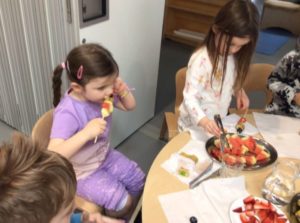
We shared lots of stories through the day and a special ‘thank you’ goes to our visitors who read stories outdoors.
There is a World Book Day Token for everyone – we hope you enjoy reading the special £1 books that you can use it to buy.
 Story stones are great resources for developing children’s communication skills, promoting their language skills and encouraging their imagination and creativity.
Story stones are great resources for developing children’s communication skills, promoting their language skills and encouraging their imagination and creativity.
Here are some ideas you can use story stones for at home..
When using the story stones use language such as:
These phrases help develop your child’s ability to predict and retell stories they are both familiar and unfamiliar with.
All you need to make your own story stones are:
If you try this at home, why not share your photographs with us on Twitter @GlenwoodFC
In all our rooms we love exploring our favourite books. We use puppets and props to help us retell traditional tales.
“The troll is scary! He tries to eat the goats. I like the bit when the goat hits him with its horns.”
Taking part in regular Bookbug sessions, we have enjoyed listening to familiar stories and we have been learning some new songs, as well as reciting our favourite nursery rhymes.
Look out for links to our Google meet Bookbug sessions next week for Math Week Scotland and you can join in from home too!
 We chose to mark the end of our first session in the new building with a Time Capsule, positioned at the front entrance and within the heart of the community in Eastwood Park, signifying our place in the heart of the community. We marked the spot with a toadstool, which came from the garden of the old building from a wooded area known as Toadstool Tales.
We chose to mark the end of our first session in the new building with a Time Capsule, positioned at the front entrance and within the heart of the community in Eastwood Park, signifying our place in the heart of the community. We marked the spot with a toadstool, which came from the garden of the old building from a wooded area known as Toadstool Tales.
This letter was placed inside the Time Capsule-
Glenwood Nursery School opened officially on 4th October, 1976 in a purpose built building on Woodfarm Road, with a capacity of 80 children in the morning and 80 in the afternoon. The first entry in the log book dated 10th November 1976 states, “ the waiting list opened on 13th September, and mothers have been enquiring daily ever since. Even at that numbers are slow to rise. At this moment we have 50 morning and 26 afternoon children. At this date we have one Head Teacher, one Assistant Teacher and five Nursery Nurses.”
The first head teacher was Mrs Elizabeth Anderson (became McDowell). She was succeeded briefly by Mrs Robertson, acting head teacher, in January 1990 before Mrs Karin Gilhooly took on the role on 3rd September, 1990. Mrs Gilhooly retired in June 2013 and I, Lorraine Brown, was appointed permanently in October 2013.
In 2015 Glenwood Nursery School became Glenwood Family Centre and we began operating throughout the year. Soon after, Scottish Government plans were announced for every child to receive 1140 hours of early learning and childcare by 2020 and so, to meet the increased demand, a new centre was planned due to open in August 2020. The new building was to be sited close to the old building. This was a much more prominent site, in the heart of Eastwood Park.
Unfortunately the COVID-19 coronavirus outbreak in 2020 resulted in the country going into lockdown and the opening of the building was delayed. The new building finally opened during a second lockdown at the start of 2021. We welcomed the first of our children on 1st February 2021, opening only to children whose parents were key workers or vulnerable children who were attending the Hub provision. The first children to step through our doors were Lewis and Cameron Wilkinson. On 22nd February 2021 we fully opened for all children. Our role at February 2021 was 141 children, with a head teacher, a principal teacher, a teacher, a depute head of centre, a senior child development officer, 16 child development officers (including 4 part time), 5 part time early years play workers, 2 business support assistants and 2 janitor/ cleaners.
The new centre has a capacity of 180 children at any one time, with children attending various patterns across the week to meet the needs of the families. Our opening hours are 8am-6pm every week day except public holidays and in-service days.
We hope that upon opening this Time Capsule, you will experience some of the thrill of learning about the past and the history of Glenwood. We have had an eventful journey recently due to coronavirus however the spirit of Glenwood is strong and we hope this continues long into the future.
Love and Best Wishes
Mrs Lorraine Brown
Head Teacher
25th June, 2021

Going to school is a big transition and children feel that. From May as children’s awareness of their move to school increases we see slight changes in the children. We often hear individuals saying to their friends or adults “I’m going to miss you when I go to school”. Some of our younger children protest “I’m going to school too”. We see some children become a little more anxious and look for more reassurance, or return to play they had previously moved on from.
At this time children also begin to explore their identity through their friendships and sometimes excluding others and we often hear disagreements about who is allowed to join in or who is in a friendship group. Recently some children made this sign:
As adults we seek to encourage children to be aware of how it feels to be excluded; and challenge children to think how and why we should include others. Parents this is a time when children will soak up the way you interact with others and your values both conscious and unconscious ones.
 At Glenwood we use the Fun Friends approach with all children. You may already be familiar with this but I am putting links to previous blogs and a sways to provide more fun ideas to support wellbeing.
At Glenwood we use the Fun Friends approach with all children. You may already be familiar with this but I am putting links to previous blogs and a sways to provide more fun ideas to support wellbeing.
F is for Feelings
We talk to children about their own feelings and others “I can see that you thought that was funny and it made you laugh but look, your friends not laughing he got a fright. https://blogs.glowscotland.org.uk/er/Glenwood/2020/05/21/remote-learning-fun-friends-have-feelings/
R is for Relaxing and Self-Regulation
Learning calm ourselves when we are scared, angry or in a disagreement is an important skill and it involves stopping a moment and breathing slowly. https://blogs.glowscotland.org.uk/er/Glenwood/2020/05/28/remote-learning-relax/
I is for ‘I can do it.’
We teach children to think positively “I can’t do it yet, but I can try hard. We call positive thoughts green as they help us go and negative thoughts red as they make us stop. https://blogs.glowscotland.org.uk/er/Glenwood/2020/06/04/remote-learning-fun-friends-i-can-do-it/
E is for Encourage
We celebrate success and encourage on the journey “you are concentrating really hard” or “I can see you are doing your very best” https://blogs.glowscotland.org.uk/er/Glenwood/2020/06/11/remote-learning-fun-friends-encourage/
N is for Nurture
We are wired for positive connection. Love can be ‘all we need’. https://blogs.glowscotland.org.uk/er/Glenwood/2020/06/18/remote-learning-fun-friends-nurture/
D is for don’t forget to be Brave.
Facing new experiences and people requires bravery. Children can practice being confident in new situations or saying they don’t like something. https://blogs.glowscotland.org.uk/er/Glenwood/?s=Fun+friends
S stay happy and stay safe
Children learn best when they are happy and safe. They love having Fun. Also they can learn safety messages when presented in fun ways.
The orchard bubble have been busy!
The orchard bubble has shown a great interest in making playdough over the last few weeks. The children have taken responsibility for their own learning by coming up with different ideas of how they want to create their playdough from colours and texture. “I want blue.”
“I want pink.”
The children had shown an interest in loose parts and wanted to include this in their playdough experience. By incorporating loose parts with playdough the children are developing their fine motor skills. They use a variety of movements such as pressing, rolling and stretching. This will help to strengthen the muscles in their hand which in turn will help them with their writing skills.
“I want to use leaves.”
“Oooohhh feathers.”
The children showed ownership over their creations and seemed to enjoy the fact that they could start again when one model was finished. They did show interest in taking them home so our next steps will be trying to create models with loose parts and clay.

“Can we take them home?”
Listening to children’s voices.
At the end of April, after every bubble had spent three weeks in each playroom every child was invited to share their thoughts. We used photographs of the playrooms to help us to talk about our likes and dislikes.
The children said they enjoyed moving around all the rooms and shared their ideas to make each room better. Some children felt that the garden in Playzone 2 was too small.
“I don’t like the garden”
“I didn’t like this because it wasn’t too big.”
We were able to begin using the side garden from Playzone 1 and expand the outdoor area for Playzone 2.
Some children missed the tyre swing from the old building so we added one to Playzone 1.
“I miss the tyre swing.”
“We should put some swings in the back yard.”
In Playzone 3 we added dolls to the home corner.
 “Can we have babies in this room?”
“Can we have babies in this room?”
“I would like to play with babies here.”
To help us look at some of the areas more closely we used Tuff Cams to share our thoughts.
“This art area is not so good. We need more things for sticky pictures.”
“People need to put things away in the right place, we need signs to tell them”.
The children suggested new resources and helped to organise and label them.
This has led to lots of new opportunities for leading their own learning.
As we continue to settle into our new building we can’t wait to hear more of the children’s ideas and suggestions to develop our learning environment.
From a very young age children benefit in all areas of their development when taking part in musicality sessions.
Over the past few weeks we have been carrying out a number of different experiments using water and food colouring. Using our observation skills we are beginning to recognise simple cause and effect. We have been developing our ability to ask relevant questions and making predictions about what will happen next.
We used different concentrations of food colouring to see what flower would change colour first.
“How fast will it go?”
“Is mine going to change colour?”
We also made our own lava lamps!
“Look at my bubbles, my bubbles are moving.”
We made a rainbow water walk.
“The colour is getting sucked up like a straw.”
“They have mixed together.”
Many of the children have been enjoying playing with the new dinosaurs. We had lots of questions so we watched some videos on Tig Tag Junior. We learned about how they became extinct.
“When a big space rock made some dust it made the place go dark. Then without sunlight the plants died. Then without plants the plant-eating dinosaurs died. Then all the meat-eaters died. Then they all started to die. Extinct.”
“What size was a T-Rex?”
We used books to research and discovered that a Tyrannosaurus rex was 12 metres long. Would it fit in our playroom? Let’s find out by measuring…

Our playroom is 10 metres long – “T-rex’s head would be next door!”  Which dinosaur is smallest? We researched on the iPad. Compsognathus was 60cm long and 40cm tall.
Which dinosaur is smallest? We researched on the iPad. Compsognathus was 60cm long and 40cm tall.

Let’s put them in order…




 This year we couldn’t invite parents in to nursery to read stories so we invited them to read to us remotely! Some were able to join us live for a Google Meet and some shared videos of themselves reading with us. A huge “Thank you!” to all our storytellers.
This year we couldn’t invite parents in to nursery to read stories so we invited them to read to us remotely! Some were able to join us live for a Google Meet and some shared videos of themselves reading with us. A huge “Thank you!” to all our storytellers.









All the children will receive a World Book Day voucher to spend – find out more in this fun song… how many stories to you recognise?
 You might like to listen to Lydia Monks read What the Ladybird Heard in a video she recorded for World Book Day.
You might like to listen to Lydia Monks read What the Ladybird Heard in a video she recorded for World Book Day.
 Sharing books and stories together is a valuable learning experience for your child. This document gives some advice on ways to get the most out of reading together.
Sharing books and stories together is a valuable learning experience for your child. This document gives some advice on ways to get the most out of reading together.
 Rhyming words are words that have the same ending sound: bat & cat, frog & log, car & star… Learning to recognise rhyme is an important step in learning to read.
Rhyming words are words that have the same ending sound: bat & cat, frog & log, car & star… Learning to recognise rhyme is an important step in learning to read.
Nursery Rhymes – Sharing songs and nursery rhymes with young children is the first step towards this and also helps create a bond with their carers.
Find out more: https://www.scottishbooktrust.com/reading-and-stories/why-share-songs-and-rhymes
The Scottish Book Trust has a Bookbug App for you to share stories, songs and rhymes together. Find out more here.
The CBeebies website also has lots of nursery rhymes to share. Click here.
Once your child understands rhyme you could make up some silly ones together… why not try Humpty Dumpty?
Humpty Dumpty sat in a tree, he fell down and hurt his …
Humpty Dumpty sat on a bed, he fell down and broke his…
Or Twinkle, Twinkle?
Twinkle, Twinkle little mouse, hiding in your little…
Twinkle, Twinkle little moon, I’d like to eat you with a …
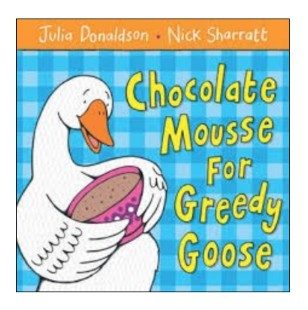 Rhyming Stories – Lots of children’s stories are written in rhyme. As you read with your child, try missing out the last word to let them fill it in.
Rhyming Stories – Lots of children’s stories are written in rhyme. As you read with your child, try missing out the last word to let them fill it in.
Here are just a few authors who write rhyming stories:
One of our favourite authors is Julia Donaldson and some of her rhyming stories have been made into animations. Why not watch some together? Zog and the Flying Doctors
Rhyme Games
 Create a rhyming basket – Collect together pairs of rhyming objects – they could be toys or household items. Take out an object… can you find it’s rhyming partner?
Create a rhyming basket – Collect together pairs of rhyming objects – they could be toys or household items. Take out an object… can you find it’s rhyming partner?
Go on a rhyming treasure hunt – Collect together some objects again but this time challenge your child to find a rhyme around your house or garden. You might put in a star (to rhyme with car), a parrot (rhymes with carrot), a bee (to match with knee or tree), a cat (rhymes with mat or hat) or a bear (to rhyme with pear). I’m sure you will think of many more!
Play I-Spy – On a walk or in the house, you could play a rhyming version of I-spy…
I spy with my little eye, something that rhymes with bee.
I spy with my little eye, something that rhymes with bog.
It’s OK if your child makes up nonsense words – that means that they have understood the concept of rhyme.
Why not play this rhyming game on the computer with Grover from Sesame Street?
Share you rhyming fun on Google Classroom or Twitter @GlenwoodFC #Glenwoodlearningathome
A brief History of Storytelling
 Story telling is said to have been dated right back to 30,000 BC where cavemen would draw pictures on the wall of their cave showing a short series of events usually depicting their rituals of hunting. 1,000 BC Greek myths and legends came about, and then in 700 BC the first written story was printed.
Story telling is said to have been dated right back to 30,000 BC where cavemen would draw pictures on the wall of their cave showing a short series of events usually depicting their rituals of hunting. 1,000 BC Greek myths and legends came about, and then in 700 BC the first written story was printed.
Benefits of Storytelling
Ideas to try at home…
Helicopter Stories
Helicopter Stories is a way of creating stories with your children. As a parent you’re the scribe and write word for word your child’s story down. Then have a go at acting it out…let your child decide who plays which character and what props to use.
Find out more in Miss MacLean’s Helicopter Stories Blog here.
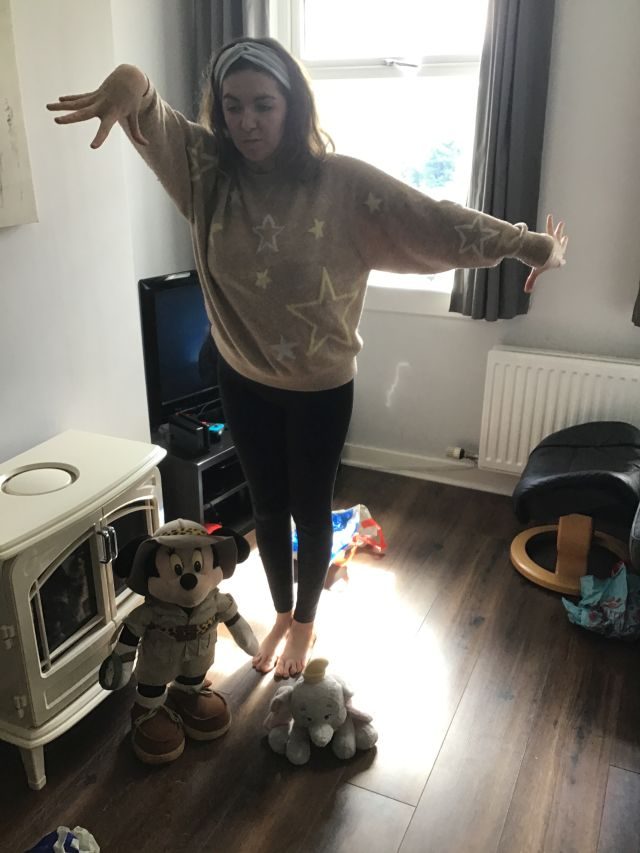
What’s in the bag?
All you need is a bag or a box filled with objects (can be anything you find around the house.) You then take turns with your child to take an object out and create a story around the object.
You could make up a station to go with the bag full of cuddly toys or dolls or toys that you could use to be the characters for your story.
This is a game that can have endless results and can be played repeatedly, as so many different stories could be told.

Hanen
In Nursery we use Hanen’s Abc and Beyond approach to develop early literacy skills. Find out more about how to turn stories into conversations in this Sway.
|
Listen to some stories together online
This ThingLink has links to many stories that you might like to share. Click on an icon to take you to the story…
We would love you to share your stories with us on Google Classroom or Twitter @GlenwoodFC #Glenwoodlearningathome
Glow Blogs uses cookies to enhance your experience on our service. By using this service or closing this message you consent to our use of those cookies. Please read our Cookie Policy.